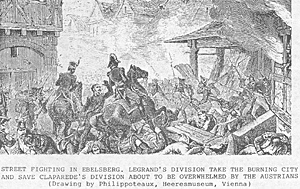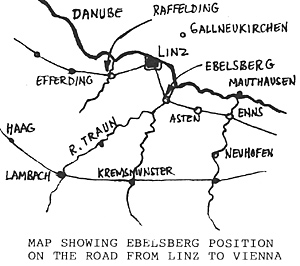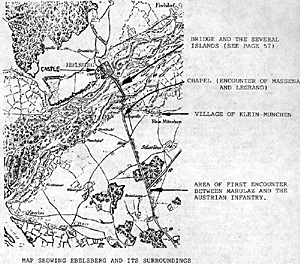 War Against Austria
War Against Austria
Elsewhere, in this issue, we are making an attempt to evaluate the French losses at the battle of Ebelsberg. Such an attempt requires a detailed battle study to (1) understand what took place and (2) to identify all the units involved.
STREET FIGHTING IN EBELSBERG. LEGRAND'S DIVISION TAKE THE BURNING CITY AND SAVE CLAPAREDE'S DIVISION ABOUT TO BE OVERWHELMED BY THE AUSTRIANS (Drawing by Philippoteaux, Heeresmuseum, Vienna)
THE ALLIED AND FRENCH TROOPS ENGAGED AT EBELSBERG
Which units were involved in the battle of Ebelsberg? It is difficult to be 100% sure. We were surprised to find in Martinien [Martinien's "Tableaux par Corps et par Batailles des Officiers Tuts ou Blesses Pendant les Guerres de 1'Empire (1805-1815)"] that some units, not mentioned by Massena and other sources, were involved like sappers of the 2nd battalion de Sapeurs , genie and artillery. They may be other units, but Martinien only reports officers casualties and, if officer casualties were not recorded, Martinien would not mention the unit at all.
A more detailed listing of the French units involved at Ebelsberg is given elsewhere in the casualties studies. Here, we are going to give only a brief lists of the Divisions involved and some specific units will be identified in the battle study.
Massena's order of march toward Linz, was (1) Trenqualye, (2) Claparede, (3) Legrand, (4) Carra St-Cyr and (5) Boudet.
THE POSITION OF EBELSBERG
PETRE's description of the Ebelsberg position is given below [Petre pp. 234]. A detailed map from Gachot [Gachot "Napoleon en Allemagne, 1809", p. 125] shows the location of Ebelsberg and its surroundings: From Wels downwards the Traun flowed close under the heights on its right bank, whilst on the left bank was a level valley about three miles broad, through which it reached the Danube in several branches. It was 15 feet deep in the main stream, with a very rapid current flowing over a stony bed. It was nowhere fordable, unless in a very dry season. The heights on the right fell steeply to the river. The main stream at Ebelsberg was 500 paces broad, the islands in the valley were marshy, and the level plain covered with sodden meadows, ditches, and small woods.
A little above Ebelsberg, the Krems flowed through a steep-sided valley into the Traun. The only approach, with the river swollen as it was by rain and melting snow, was over an embanked road and a wooden bridge of some 550 yards in length, and only 15 or 16 feet broad. This defile was easily commanded by artillery on the heights above. The bridge was closed by a tower with a gate only wide enough for one vehicle to pass at a time. Above the bridge on the north was the castle, which commanded a bridge was closed by a tower with a gate only wide enough for one vehicle to pass at a time. Above the bridge on the north was the castle, which commanded a large part of the bridge. After the gate of the bridge was passed, there was still another gate across the road before it reached the heights, and narrow streets led up steeply into the town on the right.
It would be difficult to find a position better suited for defence under the circumstances, and with the arms of 1809. Napoleon had already indicated it as the place where the Austrians would probably fight, if they did so short of Vienna.
THE BATTLE OF EBELSBERG
Ebelsberg, to ease our study, is broken in several phases, each of them is completed by some phases notes at the end of the article.
(a) Initial deployment of the Austrian forces:
Hiller received written orders from the Emperor Francis II to defend the Traun towards Lambach, with his left wing, and hold, at the same time, Ebelsberg with his right wing. If could not do this, he was to concentrate behind the Enns. [Petre, pp.234-5]
Hiller had under his command II.Reserve Corps, V. and VI Corps. Around 3 AM, on the 3 May, he started to move across the Traun, at Ebelsberg, the II.Reserve corps leading followed by V and VI. Corps. By 9 AM, only Radetzky and Vincent were still on the left bank. The Austrian forces on the left side of the Traun, i.e. protecting the bridge head, are as it follows:
(1) IR Benjowsky (#31) [Gachot, p. 125] (or at least
part of it) between the Mllhl stream and the hamlet of Reisebauer.
(2) Part of IR Spleny (#51), IR Deutschmeister (#4) and IR Klebek (#14) with Rosenberg's Chevaulegers (about 7000 infantry and 400 cavalry), apparently posted between Klein Mtinchen and Scharlinz.
IMPORTANT NOTE: one must realize that only part of the regiments mentioned above where left on the right bank of the Traun when Massena's troops made contact with Hiller's forces (apparently 6 to 7 battalions and part of a cavalry regiment) and that the withdraw to the right bank of the Traun was still going on. So, we are dealing here with a decreasing Austrian force on the left bank of the Traun, a process that started at 3 AM, which is normal procedure in a retreat situation.
Ebelsberg was, apparently, around 9-10 AM, only occupied by 3 battalions of Vienna Landwehr (4th, 5th and 6th battalions) and 3 companies of IR Lindenau [Gachot, p. 125] were in the castle, supported by one artillery battery located near the castle. The rest of the Austrian forces were behind Ebelsberg, cooking their meal according to Petre(?). It looks like Hiller was not expecting any "storming" of the bridge by the French. Massena, from the french accounts, did not look prepared for such eventuality either since he was not even around!
Battle of Ebelsberg: 3 May 1809 War Against Austria
 Early on 3 May, Marulaz joined Massena's advance guard with 4 more regiments of light cavalry and became the spearhead of Massena's troops pushing toward Linz. At WilhBring, Marulaz's cavalry found Austrians barring the defile on the Linz road and had to call Clapadere's infantry vanguard which pushed forward without difficulty into the suburb of Linz [Petre, p. 232] . Linz was found unoccupied (at 9 AM) but the bridge over the Danube destroyed. Order was given to push forward toward Vienna (via Ebelsberg), in the same order, i.e. Marulaz closely followed and supported by Claparede's infantry Division. Legrand's Division was about 3 hours behind them.
Early on 3 May, Marulaz joined Massena's advance guard with 4 more regiments of light cavalry and became the spearhead of Massena's troops pushing toward Linz. At WilhBring, Marulaz's cavalry found Austrians barring the defile on the Linz road and had to call Clapadere's infantry vanguard which pushed forward without difficulty into the suburb of Linz [Petre, p. 232] . Linz was found unoccupied (at 9 AM) but the bridge over the Danube destroyed. Order was given to push forward toward Vienna (via Ebelsberg), in the same order, i.e. Marulaz closely followed and supported by Claparede's infantry Division. Legrand's Division was about 3 hours behind them.
Let us now glance at the position which Hiller had decided to take up.
 Jumbo Ebelsberg Map (extremely slow: 331K)
Jumbo Ebelsberg Map (extremely slow: 331K)
Back to Empire, Eagles, & Lions Table of Contents Vol. 1 No. 78
Back to EEL List of Issues
Back to MagWeb Master Magazine List
© Copyright 1993 by Emperor's Headquarters
This article appears in MagWeb.com (Magazine Web) on the Internet World Wide Web.
Other articles from military history and related magazines are available at http://www.magweb.com
